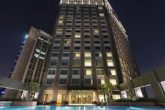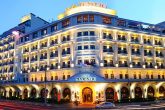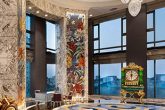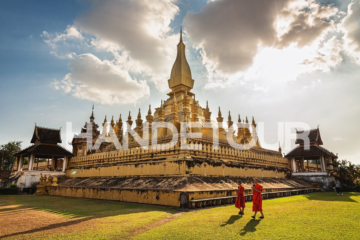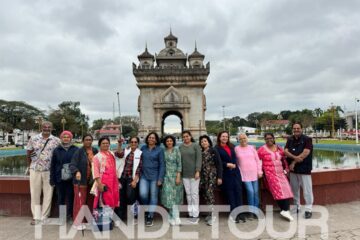Hotline: +84 913223338 - [email protected]
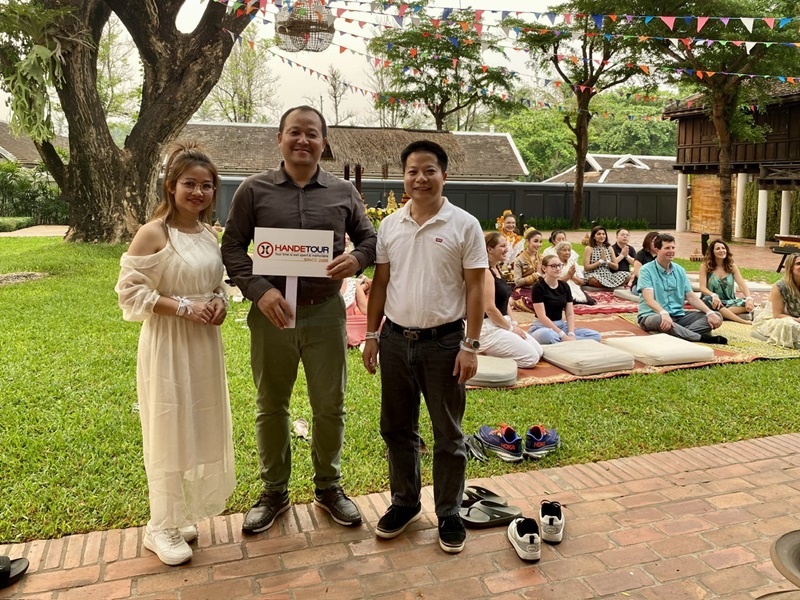
ANCIENT LAOS TOUR
- 04days/03nights
- Vientiane – Luangprabang - Pak Ou Cave - Luangprabang
-
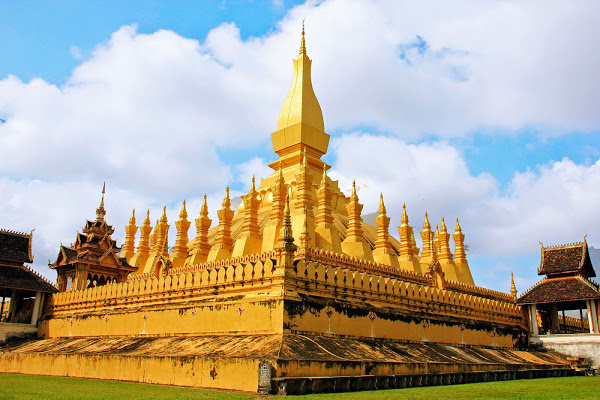 Day 1: Vientiane Arrival (D)
Day 1: Vientiane Arrival (D)Meals: Dinner at local restaurant
Accommodations at hotel
Transfer: Private vehicle
Activities for today: Upon arrival, you are met and transferred to your centrally located hotel. After a short rest, we start to visit the major sights of the capital; including the oldest Wat Sisaket with thousands of miniature Buddha statues and the former royal temple of Wat Prakeo previously housed the famous Emerald Buddha Image. On the way to the famous and sacred structure of That Luang Stupa, we stop to take some pictures of the imposing Patuxai Monument, which is well known as Vientiane’s own Arc de Triumph. From there, we visit the Central Market call ‘Morning Market’ where you can find the antique items for collection, well handmade textile and gift away items. Overnight in Vientiane.
---------------------------------------------
+ Wat Si Saket is a Buddhist wat in Vientiane, Laos. It is situated on Lan Xang Road, on the corner with Setthathirat Road, to the northwest of Haw Phra Kaew, which formerly held the Emerald Buddha
+ Patuxai Monument: literally meaning Victory Gate or Gate of Triumph, formerly the Anousavary or Anosavari Monument, known by the French as Monument Aux Morts) is a war monument in the centre of Vientiane, Laos, built between 1957 and 1968. The Patuxai was dedicated to those who fought in the struggle for independence from France. In romanising the name from the Laotian language, it is variously transliterated as Patuxai, Patuxay, Patousai and Patusai. It is also called Patuxai Arch or the Arc de Triomphe of Vientiane as it resembles the Arc de Triomphe in Paris. However, it is typically Laotian in design, decorated with mythological creatures such as the kinnari (half-female, half-bird).
+ Talat Sao (Morning market): At the eastern corner of Lan Xang Rd. and Khu Vieng Rd. in the heart of Vientiane, the morning market is open daily from 07:00 until around 16:00. The market is two-storey and covered by several sloping roofs. It is a popular tourist destination. The market consists of many small shops, restaurants, fruit and vegetable vendors; jewellery; silk; wooden crafts; musical instruments; electronics; home appliances; housewares, CDs and DVDs/VCDs, and grocery items. Depending on the time of day and the weather conditions the market can be nearly empty or full to capacity.
-
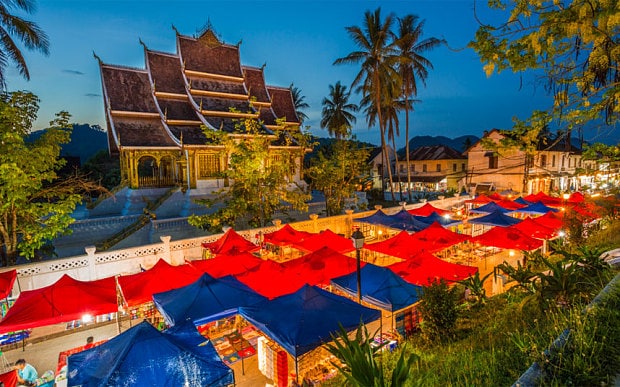 Day 2: Vientiane - Luangprabang (B/L) by flight
Day 2: Vientiane - Luangprabang (B/L) by flightMeals: Breakfast at hotel, Lunch at local restaurant
Accommodations at hotel
Transfer: Private vehicle and flight by Laos airline
Activities for today: Breakfast at hotel, we spend the day touring Lao capital, visiting the National Museum (Revolutionary Museum) where varied antique items and legend of Laos’s history fighters and leaders displace from the ancient times to new revolution period. We then board a short flight to Luang Prabang, which is perhaps the best - preserved traditional city in Southeast Asia. UNESCO registered 1995 as World Cultural Heritage City. The tranquility and charm of this town with its splendid natural scenery and cultural sights make it one of the most delightful places to visit in Asia. On arrival, we transfer you to hotel. After a short rest, we are strolling around to see the Street Night Market, where you can find the lovely collection and handmade textile by local and hill tribe people surrounding Luang Prabang, we then climb up to the top of Phousi Mount for an enjoyable exploration of the sacred, gilded stupa as well as viewing a beautiful panorama sunset over this once royal ancient city and the Mekong River. Overnight in Luang Prabang.
---------------------------------------------
+ The Lao National Museum is located in Vientiane, Laos. It was founded as the national museum highlighting the revolution of the 1970s and is located in a French colonial building. In 2007, the United States donated a grant to help develop the museum. The museum, which was originally built in 1925 as the French governor’s residence, presents the history of Laos, highlighting the Laotian people’s struggle to free the country from foreign occupiers and imperialist forces. It is located on Samsenthai road, opposite the Cultural Hall.
+ Luang Prabang night market is a must-experience. It’s an amazing sight and offers the most extensive collection of handicrafts in the country. With around 250 handicraft vendors who sell their hand-made products nightly, the market showcases an extensive variety of handicrafts made by local ethnic groups. On display are many types of textiles, exquisite ceramics, antiques, paintings, coffee and tea, quilts, shoes, silver, bags, ornaments and cutlery made from recycled bombs. There are a lot of interesting items on display at the night market that are hard to find elsewhere.
+ Phousi Mount, also written Mount Phu Si, is a 100 m high hill in the centre of the old town of Luang Prabang[1] in Laos. It lies in the heart of the old town peninsula and is bordered on one side by the Mekong River and on the other side by the Nam Khan River. The hill is a local religious site, and houses are several Buddhist shrines.
Halfway up the hill, overlooking the Nam Khan is Wat Tham Phou Si, a Buddhist temple. At the summit of the hill, overlooking the town and surrounding countryside, is Wat Chom Si, which is also a Buddhist temple and is a tourist highlight of Luang Prabang.
+ Lao Airlines is the national airline of Laos, headquartered in Vientiane. It operates domestic as well as international services to countries such as Cambodia, China, Thailand, Vietnam, and Korea. Its main operating base is Wattay International Airport in Vientiane. It is subordinate to the Ministry of Public Works and Transport.
-
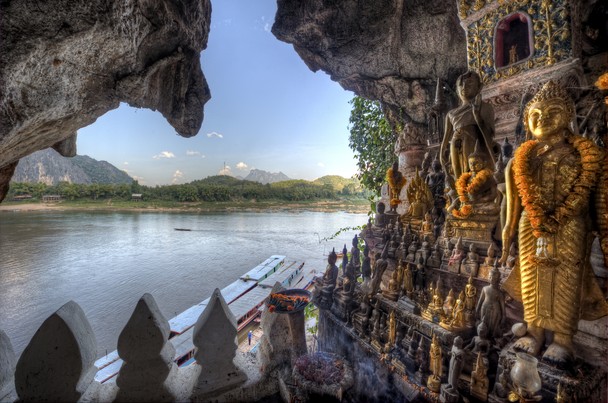 Day 3: Luangprabang - Pak Ou Cave (B/L)
Day 3: Luangprabang - Pak Ou Cave (B/L)Meals: Breakfast at hotel, Lunch at local restaurant
Accommodations at hotel
Transfer: Private vehicle
Activities for today: Breakfast, we enjoy a short-guided tour seeing the city’s oldest temple of impressive stupa of Wat Visoun and the shrine of Wat Aham, Wat Mai, Wat Sene and the magnificent Wat Xiengthong with its roofs sweeping low to the ground, which represent the classical architecture of Luang Prabang temple. We then board a boat embarking upstream on the Mekong River, which also gives us a beautiful view of the tranquil countryside as well as an interesting visit to the mysterious of Pak Ou Caves, crammed with thousands of gold lacquered Buddha statues of various shapes and sizes. Along the way, we stop at the village of Ban Xanghai, where they make the local rice wine. On return, We take a short drive to Ban Phanom, well known for its hand weaving. Overnight in Luang Prabang.
--------------------------------------------
+ Wat Visoun (Visounnalat): Built in 1512 or 1513, rebuilt in 1896-98
Wat Visounnalat was originally built during the reign of King Wisunarat (or Vixoun, 1501-1520) in 1513 (some suggest 1512) and represents the earliest style, sometimes referred to as Luang Prabang Style I, of Lao temple architecture. This style also includes the sims of Wat That Luang and Wat Mai. Wat Wisunalat is Luang Prabang’s oldest operating temple. As with the sims of most Lao wats, there are multiple roof structures. In the Style I form the first and second roofs extend around the entire perimeter of the structure. Except for the sim at Wat Mai, which was embellished by two additional gable roofs and two roofed side galleries, the style evokes simplicity, since the sim employs neither the high peaks of the gable nor the dramatic low sweeping roofs of many of the other sims of Luang Prabang. Located and adjoining Wat Aham to the southeast, it was probably built on the rice fields of the guardian spirits of the city (devata luang), Pu No and Na No (Phou Nheu and Nha Nheu). The sacred Prabang image was housed in the sim from 1513 until it was taken to Vientiane in 1707.
+ Wat Aham signifies "The Monastery of the Blossoming Heart". This temple was surely a place for mediation and meetings between spiritual culture and Buddhist practice. Neighbouring the Wat Vitsoun, it is relatively quiet even though the district has in the last few years, become the centre of Luang Prabang’s night life.
+ Wat Mai Suwannaphumaham often simply Wat Mai or Wat May is a Buddhist temple or wat in Luang Prabang, Laos. It is the largest and most richly decorated of the temples in Luang Prabang. Built in the 18th century, it is near the Royal Palace Museum. An emerald Buddha statue sits inside the red-gold interior.
+ Wat Xieng Thong ("Temple of the Golden City") is a Buddhist temple (wat) on the northern tip of the peninsula of Luang Phrabang, Laos. Wat Xieng Thong is one of the most important of Lao monasteries and remains a significant monument to the spirit of religion, royalty and traditional art. There are over 20 structures on the grounds including a sim, shrines, pavilions and residences, in addition to its gardens of flowers, ornamental shrubs, and trees.
+ Pak Ou Caves: Near Pak Ou (mouth of the Ou river) the Tham Ting (lower cave) and the Tham Theung (upper cave) are caves overlooking the Mekong River, 25 km to the north of Luang Prabang, Laos. They are a group of two caves on the west side of the Mekong river, about two hours upstream from the centre of Luang Prabang, and are frequently visited by tourists.
+ Ban Phanom is a village in Luang Prabang Province, Laos. It is located 6 kilometres (3.7 mi) east of Luang Prabang. The Lue peoples of this village are noted in particular for their cotton and silk weaving. Sale to tourists is now of prime importance to the local economy. Nearby is the Tomb of Mouhot, where Henri Mouhot lies.
-
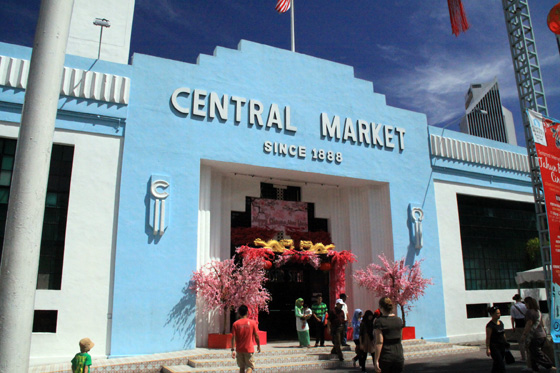 Day 4: Luangprabang - Departure (B/L)
Day 4: Luangprabang - Departure (B/L)Meals: Breakfast at hotel, Lunch at local restaurant
Accommodations: N/A
Transfer: Private vehicle
Activities for today: 06.00 Early this morning you may want to wake up early and participate in the daily early morning ritual of saffron-clad monks with their black Alms-giving bowls being given offerings from the local people, including the ubiquitous sticky rice. This is the highlight of tour prior goodbye to this charming city.
Breakfast, we then visit The National Museum at the former Royal Palace, which displays a lovely collection of the artifacts reflecting the richness of Lao culture dating from the days of the early kings right through the last sovereign. We continue visit the silver smith’s and Fine Arts School and the Central Market are not to be missed. We visit these sights before we catch a flight goodbye to this ancient city.
---------------------------------------------
+ The National Museum (former The Royal Palace) in Luang Prabang, Laos, was built in 1904 during the French colonial era for King Sisavang Vong and his family. The site for the palace was chosen so that official visitors to Luang Prabang could disembark from their river voyages directly below the palace and be received there. After the death of King Sisavang Vong, the Crown Prince Savang Vatthana and his family were the last to occupy the grounds. In 1975, the monarchy was overthrown by the communists and the royal family were taken to re-education camps. The palace was then converted into a national museum.
Rates vary frequently depending on group size, travel time, accommodation level, transportation and special touring requirements! Please contact us at [email protected] to get the best possible price.
- Private transfers
- Boat trip
- English Speaking Tour guide
- Accommodation with daily breakfast
- All entrance fees
- All meals as indicated
- 01 flight ticket (Vientiane - Luangprabang) by Laos airline
- Airport tax
- Daily bottle of mineral water
- All activities mentioned
- All service charge and government tax
- Insurance
- Personal expenses
- Tip
- Drink
- Others not mentioned
- Early check in/late checkout
- Single room
-
Day 1: Vientiane Arrival (D)
-
Day 2: Vientiane - Luangprabang (B/L) by flight
-
Day 3: Luangprabang - Pak Ou Cave (B/L)
-
Day 4: Luangprabang - Departure (B/L)

1. We are a real local tour operator and we understand our country more than others.
2. We are a legal company authorized by Vietnam Administration Of Tourism # 01-380
3. We are an official member of PATA # 6989, VITA # 2436, ASTA # 900169082, VCCI # 6178
4. We design your own itinerary without any charges, no matter how many changes.
5. We reply your request within 01 working day to save your valued time.
6. We provide qualified staff, experienced tour guide, well-maintained vehicles, good restaurants, best hotels
7. We only focus on high quality and luxury travel services to ensure our standard.
8. Listen to our customers' saying about us to see how they are satisfied with our services.






